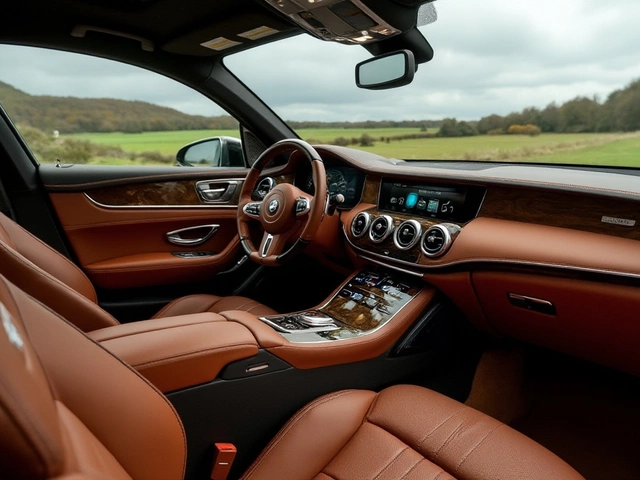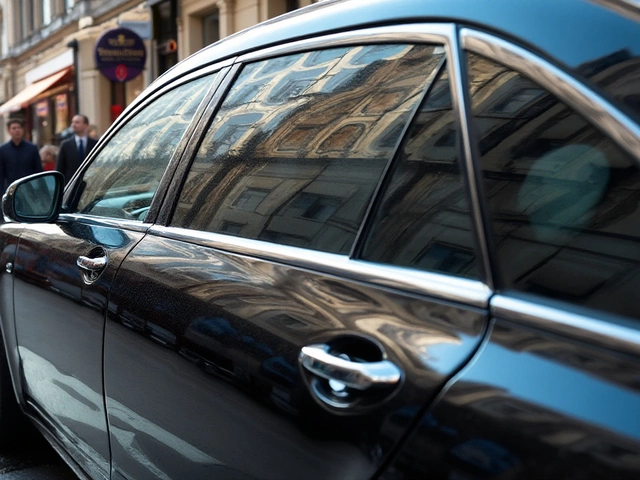Wheel spacers get a ton of attention in the world of car mods, but a lot of drivers aren’t exactly sure what they do or if they’re even worth it. Maybe you’ve seen a car where the wheels line up perfectly with the fender and wondered how they nailed that stance. Nine times out of ten, spacers are part of the secret.
If you’re after a more aggressive look or fighting tire rubbing on suspension parts, wheel spacers make life a whole lot easier. In short, they push your wheels farther out from the hub, changing how your tires sit under your car. This small change can mean a big upgrade in style and sometimes even in everyday handling—if you pick the right size and install them correctly.
- What Do Wheel Spacers Actually Do?
- Biggest Benefits: Looks, Fitment, and More
- Downsides and Risks Few People Mention
- Tips for Safe Spacer Use
What Do Wheel Spacers Actually Do?
Wheel spacers are pretty simple—they’re thick metal discs, usually made from aluminum or steel, that fit between your car’s wheel hub and the wheel itself. When you bolt them on, they push the wheels outward. This changes the position of your wheels and tires so they stick out farther than they did from the factory. If you look at side-by-side photos of a car before and after spacers, the difference can be pretty dramatic—wheels that sit flush with the fenders make any ride look more aggressive and planted.
The main job of wheel spacers is to change the wheel fitment and stance. But that’s not all. They also give you extra clearance if your wheels or tires are rubbing on suspension arms, brake calipers, or even the fender liner. This comes in handy when you upgrade to bigger brakes or choose a different set of wheels with an offset that isn’t quite right.
- If you need just a few millimeters of space to make aftermarket wheels fit, spacers can solve that without switching the whole wheel setup.
- They let you run wider tires for more grip, which can boost traction in some cases.
- Some people use spacers to help clear aftermarket suspension parts like coilovers that take up a little more space.
There’s some debate about how much spacers change driving feel. In general, they slightly widen your car’s track width (the distance between the left and right wheels). Here’s where that gets interesting:
| Track Width Increase | Effect |
|---|---|
| Small (5-10mm each side) | Minimal change—might feel a touch more stable, barely noticeable for daily driving. |
| Moderate (15-20mm each side) | Improved stance, could improve grip in corners, but too much can stress wheel bearings. |
| Large (25mm+ each side) | Very aggressive look, sometimes needed for wide tires or big brakes, but can alter suspension geometry and stress parts. |
So bottom line: wheel spacers change how your wheels sit, help with clearance problems, and let you experiment with looks and tire setups you couldn’t do otherwise. But the bigger the spacer, the more you need to pay attention to possible side effects, which we’ll dig into later.
Biggest Benefits: Looks, Fitment, and More
Let’s get real—most people start thinking about wheel spacers because of how much they can change a car’s look. If your wheels sit too far inside the fenders, spacers can help you get that flush, aggressive stance everyone loves. This small tweak actually has a bigger impact on style than a lot of pricey mods.
But it’s not just about looks. Fitment is a big deal if you’re running custom wheels, wider tires, or even brake upgrades. Sometimes, new wheels don’t clear the suspension or brake calipers—spacers give you those crucial millimeters you need. A lot of Subaru and BMW owners, for example, use spacers because aftermarket wheels can rub without them.
There’s also a performance angle. By pushing the wheels outward, spacers increase your car’s track width. For street driving, this can help with cornering stability. In fact, studies have found a wider stance can improve lateral grip by up to 10% in some cars, with the big gains happening on tighter turns. But don’t mistake this for an instant race setup—there’s a limit before things turn sketchy, which we’ll get into later.
Here’s a quick rundown of the top benefits wheel spacers bring:
- wheel spacers create a flush fitment for a better stance
- Extra clearance for bigger brake kits and custom wheels
- Reduced tire rubbing on inner fenders or suspension parts
- Potential boost to stability and handling for everyday driving
- Affordable compared to replacing your wheels or tires
Some real-world data makes it clearer. Here’s a table showing how adding a 20mm spacer affects track width and typical clearance gains on a few common cars:
| Car Model | Spacer Size | Added Track Width (per axle) | Extra Clearance (per side) |
|---|---|---|---|
| Mazda MX-5 (ND) | 20mm | 40mm | 20mm |
| BMW 3-Series (F30) | 15mm | 30mm | 15mm |
| Subaru WRX | 25mm | 50mm | 25mm |
Bottom line: spacers offer a fast, noticeable upgrade for anyone wanting to tweak fitment or get a bolder look. Just make sure you measure everything twice before buying—from spacer thickness to hub size—to avoid any headaches down the road.

Downsides and Risks Few People Mention
Alright, let’s get real about the not-so-cool side of wheel spacers. Yes, they open up plenty of options for style and function, but they’re not totally risk-free. A lot of people slap them on without thinking through what could go wrong over the long haul.
The main issue is extra stress on your car’s suspension, bearings, and studs. Because spacers push wheels farther out, they change where the weight and force hit those parts. This can lead to premature wear, or even failure, especially if you’re running bigger or heavy aftermarket wheels. There have been cases where wheel bearings wear out thousands of miles earlier than normal. Short on details? Check out this quick table for a sense of how things stack up after regular spacer use:
| Component | With Spacers | Without Spacers |
|---|---|---|
| Bearing Life (miles) | 39,000 - 65,000 | 60,000 - 100,000 |
| Stud/Bolt Stress | Up to 30% higher | Normal |
| Suspension Wear | More rapid over time | Standard rate |
Next up, wheel spacers can mess with how your car handles at high speeds or over bumps. Sometimes, you get more vibration through the steering wheel, especially if the spacers aren’t perfectly centered (a problem called “hub-centric” issues). Cheap, low-quality spacers are notorious for this, and it isn’t just annoying—it can make your ride less safe. That’s why spending a little more for a trusted brand actually matters.
There’s also the risk that your wheels or tires might rub against the fenders or bodywork. Sounds ironic, right? You install spacers to stop rubbing, but go too wide and you get it right back in a different spot—usually when you hit a bump or turn hard.
Don’t forget about legal or insurance headaches. Some places, especially in Europe, have strict rules about how far your wheels can stick out. Your car could fail inspections, or your insurance company might not cover a claim if they think spacers contributed to an accident. Always worth checking before you buy.
- Only use spacers with enough high-quality hardware (studs/bolts).
- Torque them to factory specs and double-check them after driving a few miles.
- If you hear weird noises or feel odd vibrations, don’t ignore them—stop and check the spacers right away.
Bottom line: wheel spacers do their job, but if you skip corners or ignore these downsides, you could end up with more trouble than you bargained for.
Tips for Safe Spacer Use
Getting spacers on your ride can be a simple DIY move, but there are details you can’t skip. First off, don’t just guess the size. Measure your wheel gap with a tape measure and double-check that your chosen spacers leave enough thread on your studs for the nuts to bite—usually you want at least 7 full turns for safety.
Always opt for quality materials. Cheap, unbranded spacers from random sellers can crack or warp, especially under hard driving. Stick with billet aluminum or top-rated brands made for your exact car model, not some universal fit. Hub-centric spacers are best—they match your car’s hub diameter and keep the wheels centered, killing off most vibration issues.
- Use new, longer wheel studs or proper extended bolts if your spacer is thicker than 5mm.
- Tighten lugs to your car’s torque spec. Don’t just wing it—over-torquing can actually snap the studs over time.
- After driving about 50-100 miles with new spacers, recheck the torque. Spacers can settle and lugs might work loose.
- Avoid stacking lots of thin spacers. One properly sized spacer is always safer than two or three stacked together.
If you're worried spacers might mess with handling, here's a quick fact: A 2023 test by Grassroots Motorsports found that quality spacers up to 20mm thick didn’t hurt on-road handling when everything was installed right and torqued correctly.
| Spacer Thickness | Stud Length Needed | Best Use |
|---|---|---|
| 3-5mm | Stock usually OK | Minor fitment or brake clearance |
| 8-15mm | Extended bolts/studs | Flushing wheels with fender |
| 20mm+ | Extra long studs | Extreme offset adjustment |
One last thing: check your local laws. Some areas do not allow wheel spacers on street cars, or restrict how much your wheels can poke from the fender. No one wants a fix-it ticket.






